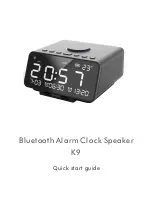
J500-41-00
4
I56-2199-003R
[
4.2] Installation For Ducts More Than 8 Feet Wide
NOTE:
To install sampling tubes in ducts more than 8 feet wide, work must be performed inside the air duct. Sampling of air in ducts wider than
8 feet is accomplished by using the ST-10 sampling tube. If the tube is shorter than the width of the air duct, install the end cap into the
sampling tube as shown in Figure 4 and support the end opposite the duct smoke detector.
Install the sampling tube as follows:
1. Drill a
3
⁄
4
-inch hole in the duct directly opposite the hole already drilled for the sampling tube. Make sure the hole is 1
″
to 2
″
below the inlet hole on
the opposite side of the duct to allow for moisture drainage.
2. Slide the sampling tube with the flange into the housing bushing that meets the air flow first. Position the tube so that the arrow points into the air
flow. Secure the tube flange to the housing bushing with two #6 self-tapping screws.
3. From inside the duct, couple the other sections of the sampling tube to the section already installed using the
1
⁄
2
-inch conduit fittings supplied. Make
sure that the holes on both of the sampling tubes are lined up and facing into the air flow.
4. Trim the end of the tube protruding through the duct so that 1
″
to 2
″
of the tube extend outside the duct. Plug this end with the end cap and tape
closed any holes in the protruding section of the tube. Be sure to seal the duct where the tube protrudes.
NOTE:
An alternate method to using the ST-10 is to use two ST-5 sampling tubes. Remove the flange from one of the tubes and install as described
above. After the installation, use electrical tape to close off some of the sampling holes so that there are a total of 10 to 12 holes spaced as
evenly as possible across the width of the duct.
NOTE:
Air currents inside the duct may cause excessive vibration, especially when the longer sampling tubes are used. In these cases a 3 inch
floor flange (available at most plumbing supply stores) may be used to fasten the sampling tube to the other side of the duct. When using
the flange/connector mounting technique, drill a 1-inch to 1
1
⁄
4
-inch hole where the flange will be used.
[5] Install The Filters
To install the sampling tube filters, simply push the filters into the sampling and exhaust tube holes, as shown in Figure 6. If a metal sampling tube is
used, install the filters over the tube end.
Figure 6. Sampling tube filter installation:
[6] Field Wiring Installation Guidelines
All wiring must be installed in compliance with the National Electrical
Code and the local codes having jurisdiction. Proper wire gauges should
be used. The conductors used to connect smoke detectors to control
panels and accessory devices should be color-coded to prevent wiring
mistakes. Improper connections can prevent a system from responding
properly in the event of a fire.
CAUTION
Filters require periodic cleaning or replacement, depending on the
amount of dust and dirt accumulated. Visually inspect the filters at least
quarterly; inspect them more often if the dust accumulation warrants it.
See Section [9.1.2] for more information. Replacement filters can be
ordered (filter P/N F36-09-11).
For signal wiring, (the wiring between detectors or from detectors to auxiliary devices), it is usually recommended that single conductor wire be no
smaller than 18 gauge. The duct smoke detector terminals accommodate wire sizes up to 12 gauge. The last foot of conduit should be flexible conduit
(available in electrical supply houses), which facilitates easier installation and puts less strain on the conduit holes in the housing. Solid conduit con-
nections may be used if desired.
Smoke detectors and alarm system control panels have specifications for Signaling-Line Circuit (SLC) wiring. Consult the control panel manufacturer’s
specifications for wiring requirements for the particular model control panel being used before wiring the detector loop.
The DH300RPL detector is designed for ease of wiring. The housing provides a terminal strip with clamping plates.
Wiring connections are made by stripping about
3
⁄
8
-inch of insulation from the end of the wire, sliding the bare end under the plate, and tightening the
clamping plate screw.
Two LEDs on each duct smoke detector may light, if programmed by the system control panel, to provide a local, visible indication. Remote LED
annunciator capability is available as an option. Each duct smoke detector can only be wired to one remote accessory.
H0131-00


























